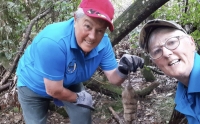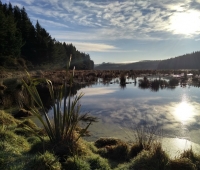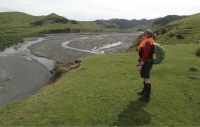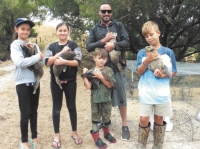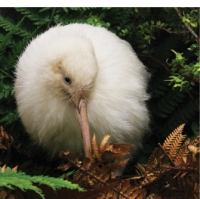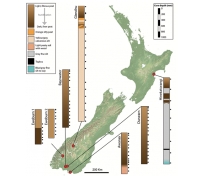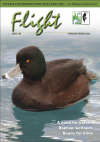
Issue 180
February/March 2021
Cover: A male New Zealand scaup or pāpango.
Photo: Photo Bernard Spragg
- A pond for pāteke
- Ramsar wetlands
- Bands for birds
Hi everyone, and a Happy New Year to you all. I am sure we would all like to think that the Covid-19 disruption to our lives might improve this year. Because of a contact that our editor, Alison, has made with the Te Henga wetland in Auckland, DUNZ has been able to create a new…
Published in
Issue 180
Tagged under
DUNZ member Mike Bourke has received the Queen's Service Medal (QSM) in the latest New Year's honours for his services to wildlife conservation. The citation for his award says Mike has developed large sections of his family’s farm in Rangiwahia into a wildlife reserve and habitat of more than 30 acres. He began transforming his…
Published in
Issue 180
Tagged under
Te Henga wetland, which covers 160 hectares and is the biggest in Auckland, has the potential to be the ideal wildlife habitat with acres of reeds, raupō, sedges, open water ponds and the Waitākere River coursing through it. Forest & Bird’s project Habitat te Henga was born from a desire to protect the wetland. It…
Published in
Issue 180
Tagged under
The number of whio in the Tongariro catchment is growing, thanks to a recovery plan run by the Departmentof Conservation from 2009 to 2019 and groups of volunteers who monitor hundreds of traps in the region. Two Taupō Fishing Club members and dedicated trappers Chris Pritt – the sister of DU Patron Di Pritt –…
Published in
Issue 180
Tagged under
"The best bang for your buck" is how New Zealand Game Bird HabitatTrust Chair Andy Tannock described Takitakitoa Wetland in Otago on September 19. Trustees visited the wetland near the Taieri River during the annual meeting of the trust which was held in Dunedin. It was the first meeting of the new board appointed by…
Published in
Issue 180
The Game Bird Habitat Trust was established by the Wildlife Act 1953 and must comply with the Crown Entities Act 2004 as per the 4th Schedule of the Public Finance Act 1989. There are a range of functions set out in section 44D of the Wildlife Act, but primarily it is to improve New Zealand’s…
Published in
Issue 180
Tagged under
An ambitious predator control programme in and around the Aorangi Forest in the southern Wairarapa is delivering some impressive results. The Aorangi Restoration Trust is working in partnership with TBfree NZ, which has carried out three aerial applications of 1080 aimed at controlling possums and rats, covering 33,000 hectares. The first 1080 drop was in…
Published in
Issue 180
Tagged under
DU's inaugural scholarship recipient Shannon Bentley is in the final stages of analysing data for her thesis on wetland restoration. She says she is exploring how restoring wetlands from pasture changes plants, microbes and soil. "Restored wetlands are home to more diverse native plant communities and soil microbial communities than pastures, preliminary results show. "This…
Published in
Issue 180
Tagged under
BOOK REVIEW The Forest for the Trees, by Wayne Bennett I found this book easy to follow in a well laid out and simple format that seems suited for those at all levels of native restoration – with mine at the beginners' end. Although based on a plot in the Waikato, essentially the methodology can…
Published in
Issue 180
Tagged under
To celebrate World Wetlands Day on February 2,which marks the signing of the Ramsar Convention in 1971, Department of Conservation staff provide a rundown of Ramsar sites in New Zealand. More than 10,450 hectares of Wairarapa Moana became a Ramsar site in August – including the Wairio wetland that Ducks Unlimited has been instrumental in…
Published in
Issue 180
Tagged under
Anyone reporting a duck band is eligible for some great prizes, so leaving bands in the maimai is a sort of lose-lose for everyone. The first group to use modern bird bands in New Zealand was the Southland Acclimatisation Society in 1911. It ordered 100 aluminium bands from the United States marked “S” and 1…
Published in
Issue 180
Tagged under
Pukaha Wildlife Centre's summer was overshadowed by the death of their treasured white kiwi, Manukura, who was farewelled in a special service on January 9. However, Pukaha’s captive breeding ranger Tara Swan says there have been "lots of positive, happy things happening in the bush since our dear Manukura left us”, including the hatching of…
Published in
Issue 180
Tagged under
A study has shown that environmental DNA, known as eDNA, may be valuable in measuring biological changes in wetlands. The eDNA is extracted from soils, air, water, and other substrates. Researchers from Manaaki Whenua – Landcare Research sequenced microbial DNA from soil cores taken down to 4 metres below the surface in seven New Zealand…
Published in
Issue 180
Tagged under




